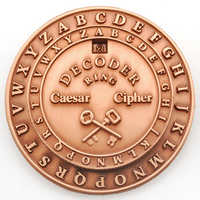

 |  |
As an example, suppose you wanted to encode the word "AWESOME". To do this with the secret decoder ring shown below, we would turn the outside ring by some amount, noting the letter on the outer ring that then matches up with the letter "A" on the inner ring. In the ring shown, we see this is the letter "C". In this particular model, one can also see a small "3" in the window below the inner ring's "A", since "A" is lined up "C" and "C" is the third letter of the alphabet.

Upon inspection, we can see that almost every letter of the inner ring is now paired with a letter on the outer ring that is 2 letters "forward" in the alphabet. (note: the shift forward will always be one less than the number shown in the window) For letters "Y" and "Z", since we don't have enough letters to go "forward 2" without surpassing the end of the alphabet, so we wrap around to the beginning, matching "Y" with "A" and "Z" with "B".
Replacing each letter of our intended message "AWESOME" with its outer-ring counterpart, we arrive at the encrypted message: "CYGUQOG"
Decrypting is just as easy. One would rotate the outer dial so that "C" on the inner dial is lined up with the "A" on the outer one. Then, each letter of the encrypted message should be replaced with the letter on the outer dial that lines up with it as found on the inner dial.
When we encrypt something in this way, we are using what is called a Caeser cipher. The number of letters shifted functions as the secret key. Knowledge of this secret key makes decrypting easy - so it should be shared with the intended recipient of your secret message.
Despite the fact that Julius Caesar used it to protect messages of military significance -- this is actually a really terrible means of encryption. One can easily decrypt such messages whether they have the secret key or not -- as there are only 26 possible "keys" that could have been used. One can simply try to decode the message with all 26 of them, being aware that only one is likely to result in a meaningful message.
Curiously, this method of encryption does still find use even in modern times in one context: ROT13.